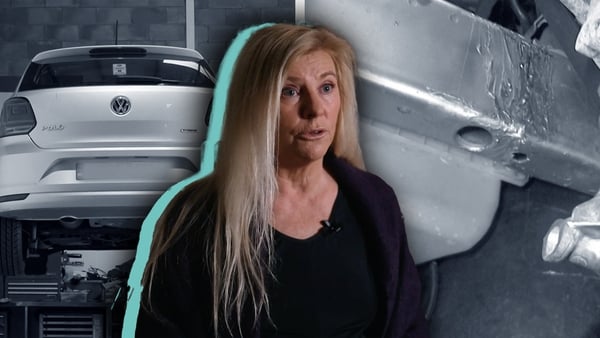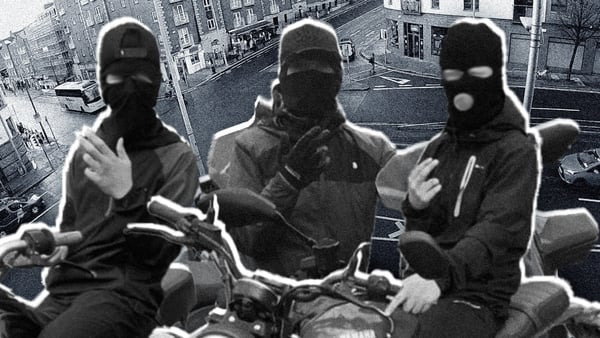As car thefts in Ireland hit a 12-year high, a loose network of teenage joyriders is at the heart of a growing crime wave.
For the brother of Michael Farrelly, killed in a hit-and-run by a stolen car, the crisis is personal — and the justice system, he says, is failing to respond.
Forty-one-year-old Dubliner Michael Farrelly spent the final evening of his life watching Riverdance with family members in Dublin's Gaiety Theatre. They then went for food and drinks near where he lived in Sutton, Co Dublin.
After midnight, they said their goodbyes and Michael began walking home.
By 1am he was on the ground, dying, mown down in a hit-and-run by a stolen car.
Two teenagers are suspected to have been in the car, which had been stolen in Malahide.
"He was due to be my best man at my wedding," Michael’s brother Conor told Prime Time.
"We just incredibly close relationship, typical older brother, younger brother…loved each other completely."

The hit-and-run is a deep tragedy for the Farrelly family, but it also exposes a deep weakness in our criminal justice system.
Nobody has been charged yet in relation to the incident. Prime Time understands there are two suspects and both are known car thieves. One of them has already amassed more than 40 convictions in his young life.
"At least one of the people in the car was actually on bail and under curfew at the time the accident happened," Conor said. "He shouldn't have been out. He should have been at home."
After Michael Farrelly was killed, the teenager didn't give up joyriding. He has since been arrested or prosecuted in relation to eight separate incidents, including four car thefts.
"It’s shocking, you know? Like to think that someone can have that many convictions, take a life and still be getting arrested. That's once a month since it happened. It's just a very difficult thing to hear," Conor said.
The suspect in the hit-and-run with more than 40 convictions has since turned 18. He is in detention, having been arrested as an adult in relation to a recent car theft.
Lucky Dip gang
Gardaí believe he is one of the leading members of the so-called 'Lucky Dip’ gang - so called because they choose to target areas at random.
The gang is "a group of up to 60 juveniles," according to Irish Independent Crime Correspondent Ken Foy, who has been closely following their activities.
"They are all males, the average age of these guys is 17, but some of them are as young as 14. The vast majority are from Dublin."
Mr Foy says they have already been linked to around 300 incidents in the first three months of this year alone.
"Not all of them are car thefts. Some of them are burglaries, some of them are attempted burglaries, some of them are robberies," he said.

Internal garda figures seen by Prime Time show that 11 particularly active members of the gang have been charged a combined 427 times - an average of 39 times each.
The average age of those identified is 16.
An Garda Síochána have the group in its sights. An internal document describes "the composition of the grouping," "their level of offending together" and suggests that gardaí are currently considering whether to categorise it as an "organised crime group."
Sergeant Mark Bolger of the Garda National Crime Prevention Unit said says such a determination would necessitate "an investigation on a grander scale" to establish the extent of organised criminal behaviour.
Unlike established professional car thieves who steal for profit, the Lucky Dip gang do not typically sell on the cars they take, they are stealing for the purpose of joyriding.
"They will go out to housing states dotted around the Eastern Region, the Dublin Metropolitan Region, and they will just go along and simply just try every car door in a particular housing estate," Sgt Bolger said.
"They are not mastermind criminals. They're simply looking for an easy opportunity."

Vehicle theft and related offences are not a new problem, but they have surged in recent years.
In 2024, they hit a 12-year high of 7,919 incidents - more than double the 2021 figure of 3,955, according to the Central Statistics Office.
The Lucky Dip gang are believed to have made a significant contribution to this upsurge.
We need your consent to load this flourish contentWe use flourish to manage extra content that can set cookies on your device and collect data about your activity. Please review their details and accept them to load the content.Manage Preferences
While they primarily operate at night, they flaunt their behaviour, sharing footage of their joyrides on Snapchat and TikTok.
"They love social media," says Ken Foy.
"Their mates are seeing it and all that kind of stuff. But the problem is that this is inspiring other youngsters."
Videos posted show teenage car thieves racing through residential streets, down motorways, and even driving against oncoming traffic - all posted for likes, views, and bragging rights.
Mr Foy says that unlike traditional organised crime groups, the Lucky Dip gang has its roots in connections forged online.
"A traditional organised crime gang starts out in a particular estate or a particular area. It's not like that. Many of them appear to have come into contact with each other via social media," he said.
Garda pursuits
These joyrides aren’t just reckless, they’re dangerous, not only to the public but also to gardaí tasked with stopping them.
That risk has led to a major shift in how An Garda Síochána deals with stolen vehicles on the road.
"The most significant change, I suppose, is that a pursuit can take place within certain conditions," said Sgt Bolger.
Before engaging, the garda at the scene must weigh up several factors: "Is the pursuit worthwhile? What offense has possibly been committed? The possibility of danger to the members of the public, and to our colleagues as well. We don't want to put anybody in danger, and particularly the driver of the other vehicle or potential passengers that are in that suspect vehicle as well," Sgt Bolger said.
Pursuing stolen cars can carry professional and legal risks for gardaí.
Prime Time has seen a copy of the most recent garda pursuit policy. It includes a list of ten criteria that gardaí must consider before spontaneously pursuing a stolen car.
The policy runs to 13 pages and references a further 13 documents, the key points of which gardaí must consider in the heat of the moment.
The Garda Representative Association is heavily critical of the policy.
"All the policy documents that exist in respect of pursuit-driving are all heavily swayed in favour of the criminal that might visit your estate and take your car, and not towards the gardaí that are tasked with apprehending these individuals," Niall Hodgins, Vice President of the GRA, said.
"Everything is all right until it goes wrong," he added.
And when it does, it’s the individual garda who made the split-second decision to pursue that becomes the subject of investigation, according to Mr Hodgins.

'Capacity is full’
Despite their young age and repeat offending, some amassing hundreds of thefts, and repeated bail breaches, members of the group have rarely been placed in long-term detention.
Under the Children’s Act, "a period of detention should be imposed only as a measure of last resort" on any child.
Children who steal cars are usually dealt with under the Garda Youth Diversion Programme for the first few offences, which means no criminal conviction.
Those who continue to offend and end up being prosecuted are virtually always granted bail pending their court case, according to gardaí.
Even when convicted, the car thieves are typically given non-custodial sentences because they are children and because car theft is considered a non-violent crime.
As Ireland no longer incarcerates children in adult prisons, the only detention facility for minors in the State is the Oberstown Campus in north Dublin.
However, Oberstown is operating at or near capacity consistently, and those children convicted of or accused of violent crime are prioritised.
"As recent as January this year, bed capacity in the children's facility in Oberstown was full for 24 straight days," Mr Hodgins, of the GRA, said.
"We have been successful and made a number of detections in this type of crime ... And to see the individual back out in the street the next day is very, very disheartening for our members," he added.
The frustration felt by gardaí is echoed by victims’ families, who see the consequences of this cycle play out in the most devastating way.
"It makes you think that we have no proper solution to deal with people who can go out and steal a car, get arrested, go before the courts, be bailed, be put on curfew. And then they're brought home, they walk in the front door, and then they walk straight out the back door, and they do it again that night," Conor Farrelly said.
"It seems like there's no protection given for the victims. Their lives have been taken away from them and their family's lives destroyed."
Japanese imports
Teenage car thieves frequently target smaller used cars imported from Japan, which, unlike European Union-made cars, often do not have a factory-fitted immobiliser - meaning they can be started without a key.
"If a car doesn't have an immobiliser, it essentially leaves it open and susceptible to hot wiring," explained Sgt Bolger.
"We go back to the old 1980s pre-immobiliser days, where you're effectively back to using a steering lock or a steering chain as a visible and physical deterrence to somebody who may be considering stealing your car," he added.
Japan’s popularity as a source of cars is because its cars are right-hand drive and therefore suitable for Irish roads. And they have a reputation for being well maintained and in good condition.
The country has overtaken the UK as our main source of used cars, with registered imports rising 1151% from 2,321 in 2015 to 29,050 last year, according to figures from the Society of the Irish Motor Industry.
"Since Brexit, because of the increase in VRT, excise, and VAT, it's quite difficult to import cars from the UK. So, a lot of the cars are coming from Japan," says Noel Maher, an Automotive Engineer with Automotive Technical Expert Consultant Engineers Assessors (ATECEA Ltd).
This shift has inadvertently expanded the number of vehicles on Irish roads that are both easier to steal and easier to drive, making them a prime target for teenage joyriders.
Mr Maher suggests that the Revenue Commissioners, whose role is to tax imported cars, should insist that they be fitted with immobilisers.
Insurers could then give "a reduction in the insurance premium because the chance of theft is reduced," he said.
When asked about insisting on immobilisers, the Revenue Commissioners directed the query to the Department of Transport, who said it is "not currently considering making immobilisers mandatory for all cars or other vehicles.
"Requiring them to be fitted to cars imported from Japan, would also mean requiring them to be retrofitted to any car without one already installed, as well as those older vehicles being imported from other EU Member States," the Department’s statement said.
"The Department understands that the cost of fitting these devices can be up to €500, and this would be a significant burden to make mandatory for those motorists. Lower cost alternatives are available, including steering wheel locks."
According to Mr Maher, however, steering locks may be a deterrent, but they are not a significant obstacle for a determined car thief.
"Most prepared car thieves will have an angle grinder, a chain snipper or a dead-bolt cutter," he said.

In the meantime, imported cars will continue to be favoured by teenage thieves who sometimes upload footage of them joyriding small Japanese imports while goading gardaí who are monitoring them - or chasing them - in more powerful patrol cars.
The rise in car thefts may be influenced by a range of factors - from the growing number of easy-to-steal imported vehicles to the limits of youth detention and prosecution.
Alternative approaches
With victims’ families feeling abandoned, the question remains: what can be done with prolific child car thieves who consistently ignore bail conditions?
"One of the things that has been really effective in the youth justice system is the Bail Supervision Scheme," according to Saoirse Brady, Executive Director of the Irish Penal Reform Trust.
Ms Brady says its success is largely attributed to its multidisciplinary approach. Teams go into the home, engage directly with the young person, and work to understand and address the underlying issues driving their behaviour.
The programme was extended to from Dublin to Limerick and Cork after a positive evaluation showed low rates of reoffending. But what about those who simply refused to engage?
"We need to ask why? Young people who engage in crime, they're very often leading very chaotic lives. They may have underlying issues as well, whether those are mental health issues, whether they've suffered the loss of a parent, maybe parents aren't in the picture," Ms Brady said.
"In any other circumstances, you probably have a lot more public sympathy for those, children and young people. But when it comes to youth justice, because of the nature of their behaviour, we don't always have that sympathy," she added.

But for Conor Farrelly, the bigger question is whether enough is being done to prevent this kind of tragedy from happening again.
"A lot of people have said to me in sympathy that 'Poor Mikey, he was at the wrong place at the wrong time'.
"But he wasn't, he was exactly where he should have been after a night out with his family.
"He was just walking home, and he was almost there before he was hit."
A report into rising car thefts from Paul Murphy and Isabel Perceval is broadcast on the 3 April edition of Prime Time on RTÉ One and the RTÉ Player.





